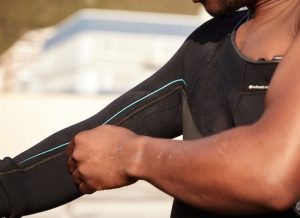Scuba diving, a captivating underwater adventure demands thoughtful considerations when it comes to the choice of diving gear. One critical decision faced by divers is the selection of wetsuits packages, with a particular focus on full suits and shorty wetsuits. This article will discuss the advantages and disadvantages of each, highlighting the necessity to strike a delicate balance between thermal protection and freedom of movement.
The Versatility of Full Suits
Advantages
 A full neoprene wetsuit offers coverage of the entire body, providing thermal protection for the whole body. The thickness of these wetsuits varies, commonly ranging from 3mm to 7mm. The 3mm wetsuit is suitable for warm waters, offering enough insulation without causing overheating.
A full neoprene wetsuit offers coverage of the entire body, providing thermal protection for the whole body. The thickness of these wetsuits varies, commonly ranging from 3mm to 7mm. The 3mm wetsuit is suitable for warm waters, offering enough insulation without causing overheating.
On the other hand, the 7mm wetsuit becomes the go-to choice for colder environments, ensuring the diver remains comfortably warm.
One notable advantage of full suits is their ability to maintain consistent body temperature during extended dives. The coverage protects against hypothermia, allowing divers to explore underwater landscapes without the constraints of changing conditions. This makes full suits an excellent choice for divers seeking a versatile option that can adapt to diverse underwater environments.
Disadvantages
However, the suit covering the whole body can sometimes impede freedom of movement. The thickness of the neoprene wetsuit, especially in 7mm wetsuits, may restrict agility, making it challenging for divers to navigate through tight spaces or perform intricate maneuvers. This limitation becomes apparent in scenarios where the underwater terrain demands flexibility.
Moreover, full suits can be bulkier and heavier than their shorty counterparts. This can be a drawback for those traveling to diving destinations where luggage space is often limited. Additionally, donning and doffing a full suit can be more time-consuming, potentially reducing the efficiency of a diving expedition.
The Freedom Offered by Shorty Wetsuits
Advantages
 Shorty wetsuits, characterized by shorter arms and legs, strike a balance between thermal protection and freedom of movement. These wetsuits are ideal for warmer waters where the need for a full suit may be unnecessary, with the discomfort it may cause.
Shorty wetsuits, characterized by shorter arms and legs, strike a balance between thermal protection and freedom of movement. These wetsuits are ideal for warmer waters where the need for a full suit may be unnecessary, with the discomfort it may cause.
The reduced thickness of a 3mm wetsuit ensures that divers stay warm without the risk of overheating.
One notable advantage of shorty wetsuits is their ease of use. Donning and doffing these suits is a quick process, allowing divers to spend more time underwater and less time in transition. They’re are also the preferred choice for travelers, as shorty wetsuits take up less luggage space.
Disadvantages
The reduced covering provided by shorty wetsuits means that the arms and lower legs, are more exposed. This leaves divers vulnerable to cuts, scrapes and potential stings from marine life. The limited thermal protection also makes shorty wetsuits unsuitable for colder environments, putting divers at risk of hypothermia in chilly waters.
Balancing Act: When to Choose Full or Shorty Wetsuits
The decision to choose between a full suit and a shorty wetsuit ultimately depends on the diving conditions and personal preferences. In warmer waters where the primary concern is protection against the elements without sacrificing mobility, a shorty wetsuit is a practical choice. On the other hand, in colder environments where thermal insulation is needed, the 7mm wetsuits become the more suitable option.
Factors Influencing the Decision
Gendered Wetsuits: A wetsuit for men and women takes into account the distinct body shapes and proportions. A well-fitted wetsuit for men or women not only enhances comfort during the dive, but also plays a crucial role in maintaining optimal thermal insulation. Ill-fitting suits may lead to discomfort or chafing, impacting the overall diving experience. Therefore, selecting the right size and ensuring a snug fit is essential for the effectiveness of shorty or full wetsuits for women or men.
Water Temperature: The key factor influencing the choice of wetsuit is the temperature of the water. Warmer waters call for the flexibility and lighter insulation of a shorty wetsuit, while colder environments require the full covering and enhanced thermal insulation provided by 7mm wetsuits.
Duration of Dive: The length of the dive is another important consideration. Longer dives in cold waters may require the extended thermal protection of a full suit, whereas shorter dives in warmer conditions may benefit from the increased mobility offered by a shorty wetsuit.
In essence, the world of scuba diving offers particular choices when it comes to wetsuits. Whether opting for the full body covering of the neoprene 7mm wetsuits or the freedom of movement provided by a shorty wetsuit, divers must carefully weigh the advantages and disadvantages to make an informed decision. The key lies in finding the balance between thermal protection and freedom of movement that suits the individual needs and preferences of each diver.

